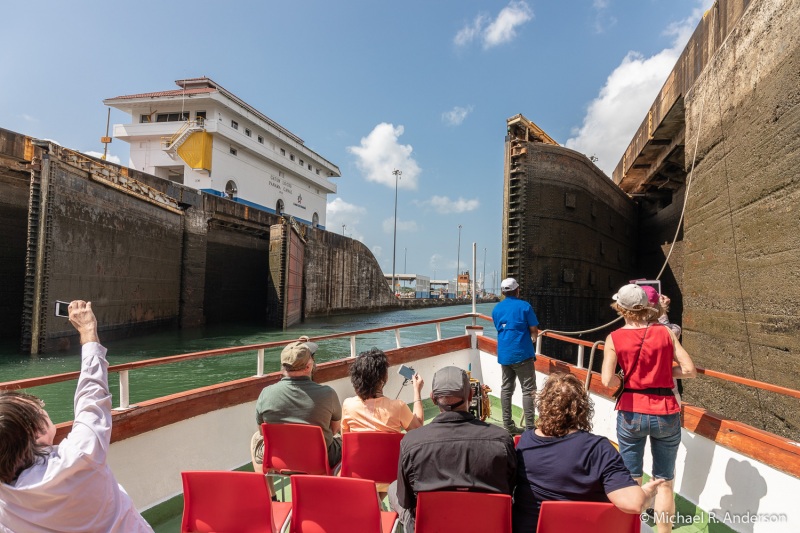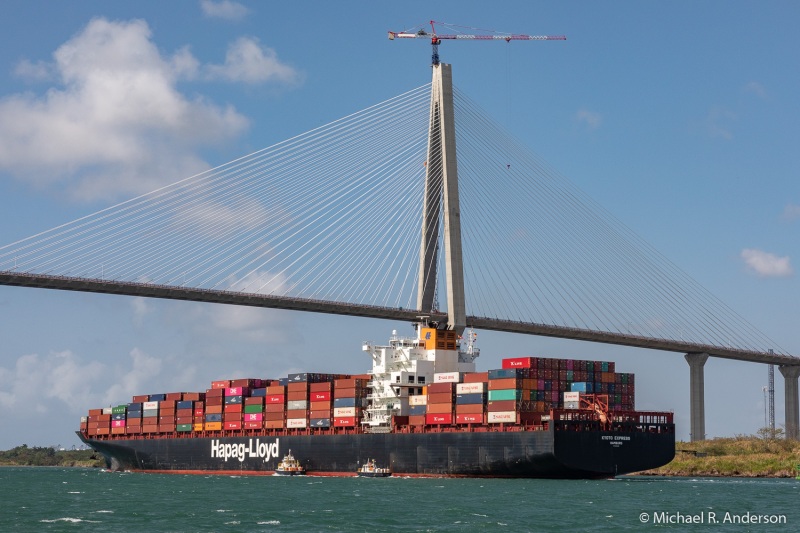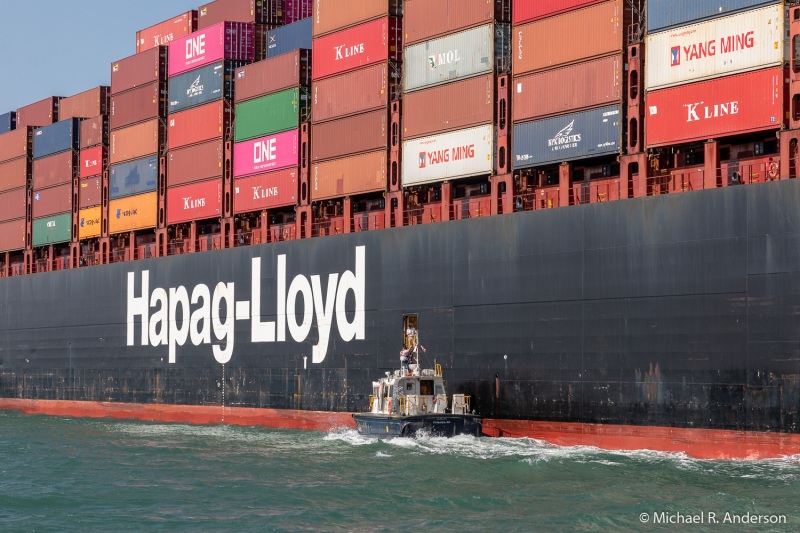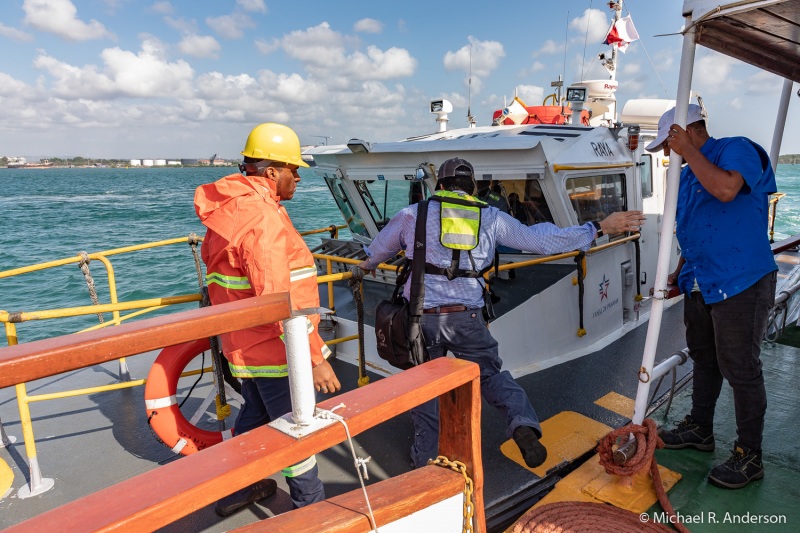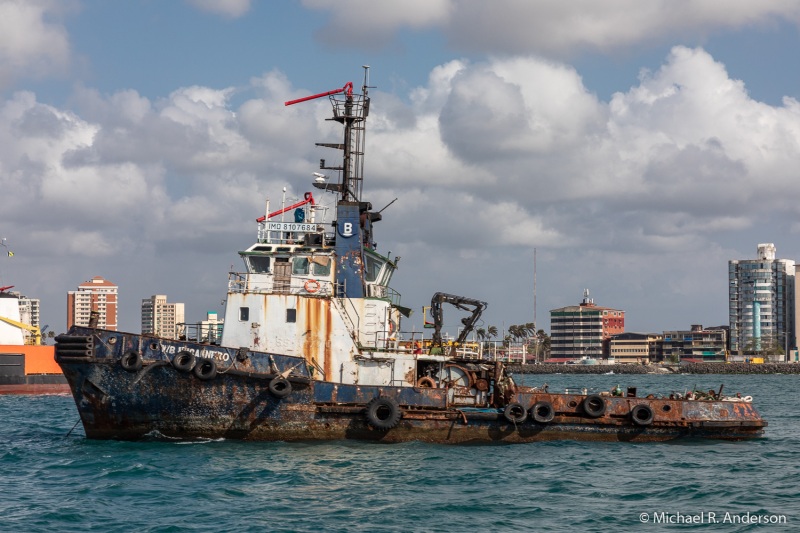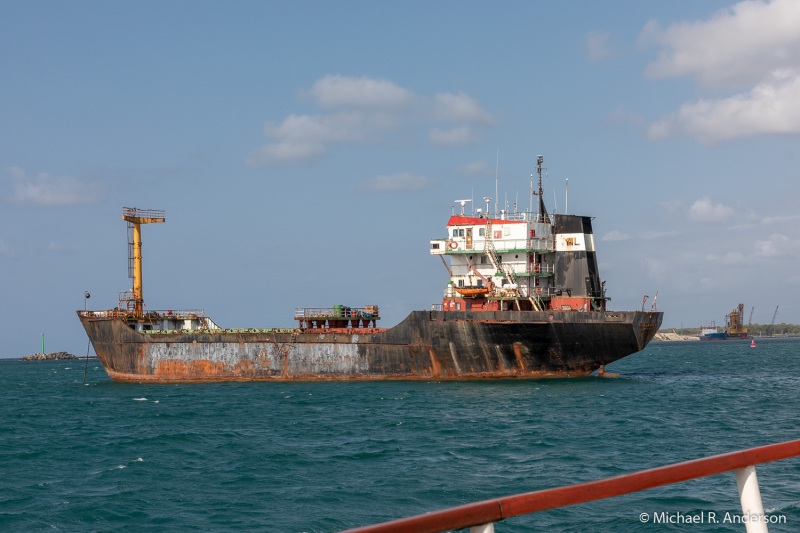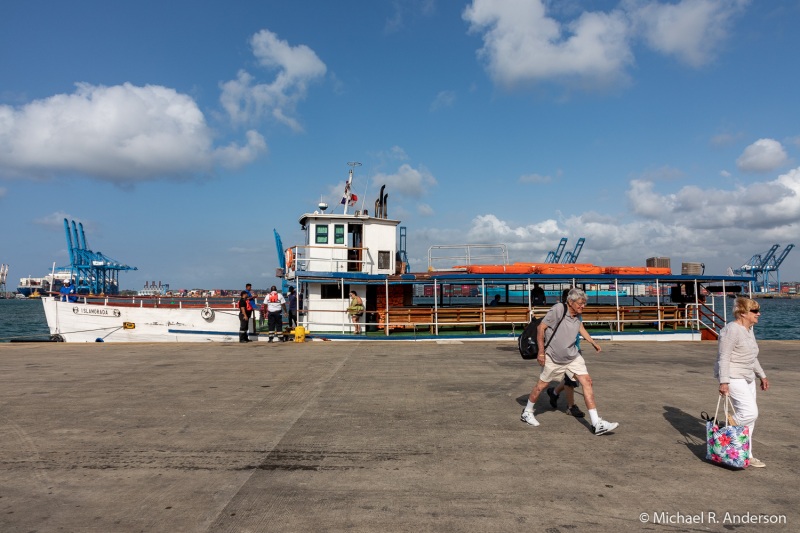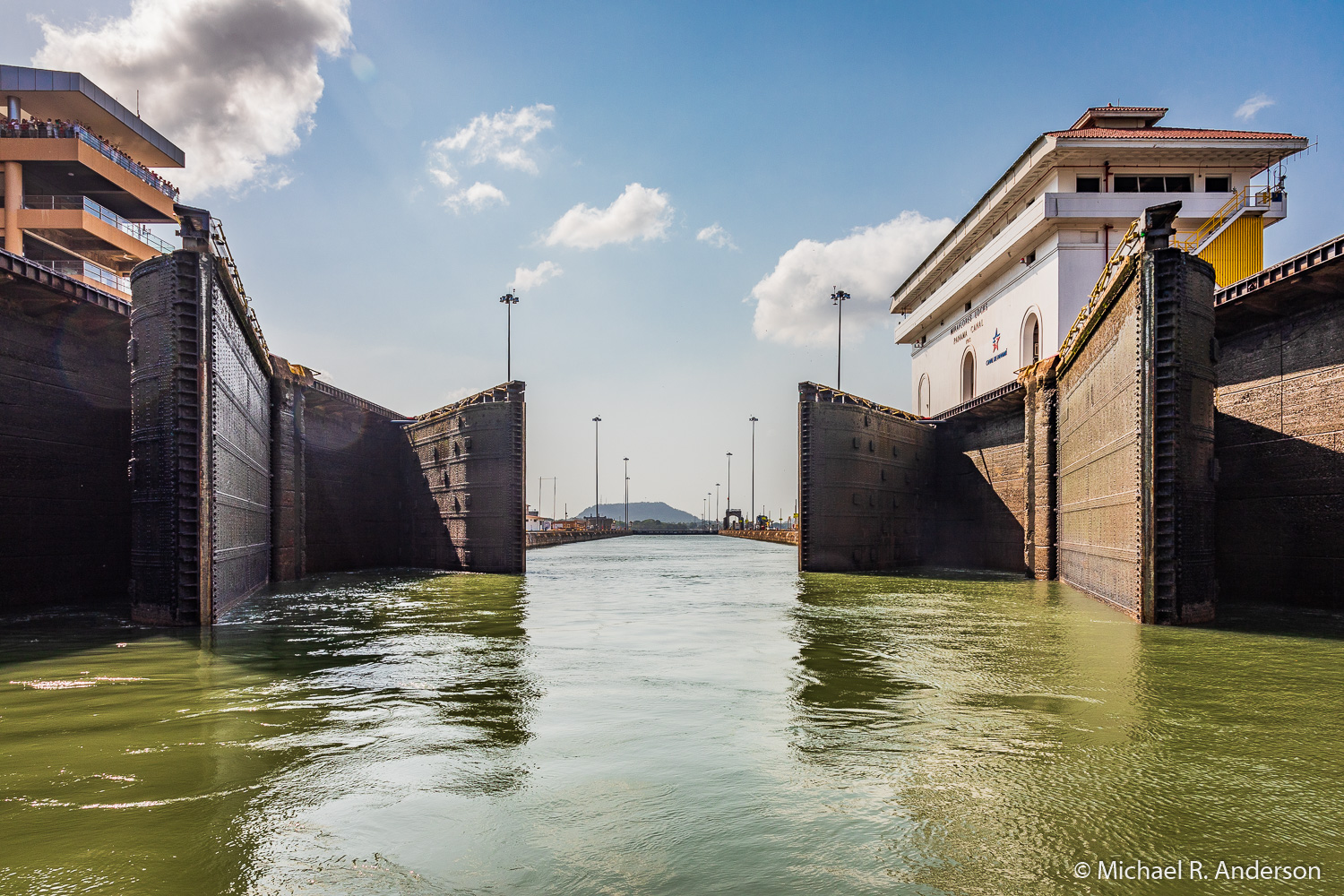
We awoke at 5 AM. The night’s full moon had not quite set and the previous day’s high temperature of 91° F had plunged to an overnight low of 79° F. Our suitcases were ready for the bus at 5:30. There was no buffet breakfast waiting because we’d be eating aboard the boat that would take us through the canal. By the time the sun rose at 6:22, we were boarding the Islamorada, a 107-year-old boat that was once used by Al Capone to run rum from Cuba to Key West. Unfortunately, there was no rum aboard when we arrived. Fortunately, a cooler full of beer was brought out in the afternoon. After a brief introduction to the day’s events by our guides, we headed out.
As we pulled out of the marina a lot of ship traffic was visible in the distance. We were close to the Navig8 Constellation, a tanker sailing under a Marshall Islands flag, which we would be following the first part of the trip. Our first important order of business was to pick up our pilot. Every ship passing through the canal, even small ones like our 100-foot vessel, must be under the control of a member of the Panama Canal Pilots Association. Picking up a pilot was not much of a delay. A boat simply pulled up alongside the Islamorada and the pilot jumped aboard. Then we headed out under the Bridge of the Americas to the locks.
* * * * *
We now pause for a brief bit of educational information about the Panama Canal:
When the French started the canal in 1880, they planned, despite the concerns of many engineers, to dig straight through the isthmus. This “sea level” canal would have no locks; it would be as if the Americas were split in half by the canal through Panama. That plan failed with a major scandal and the loss of many millions of francs. The French sold their buildings and excavation equipment to the US and the American engineers changed the plans to the lock and dam system that exists today. (The story is much more complicated than that but you get the idea.)
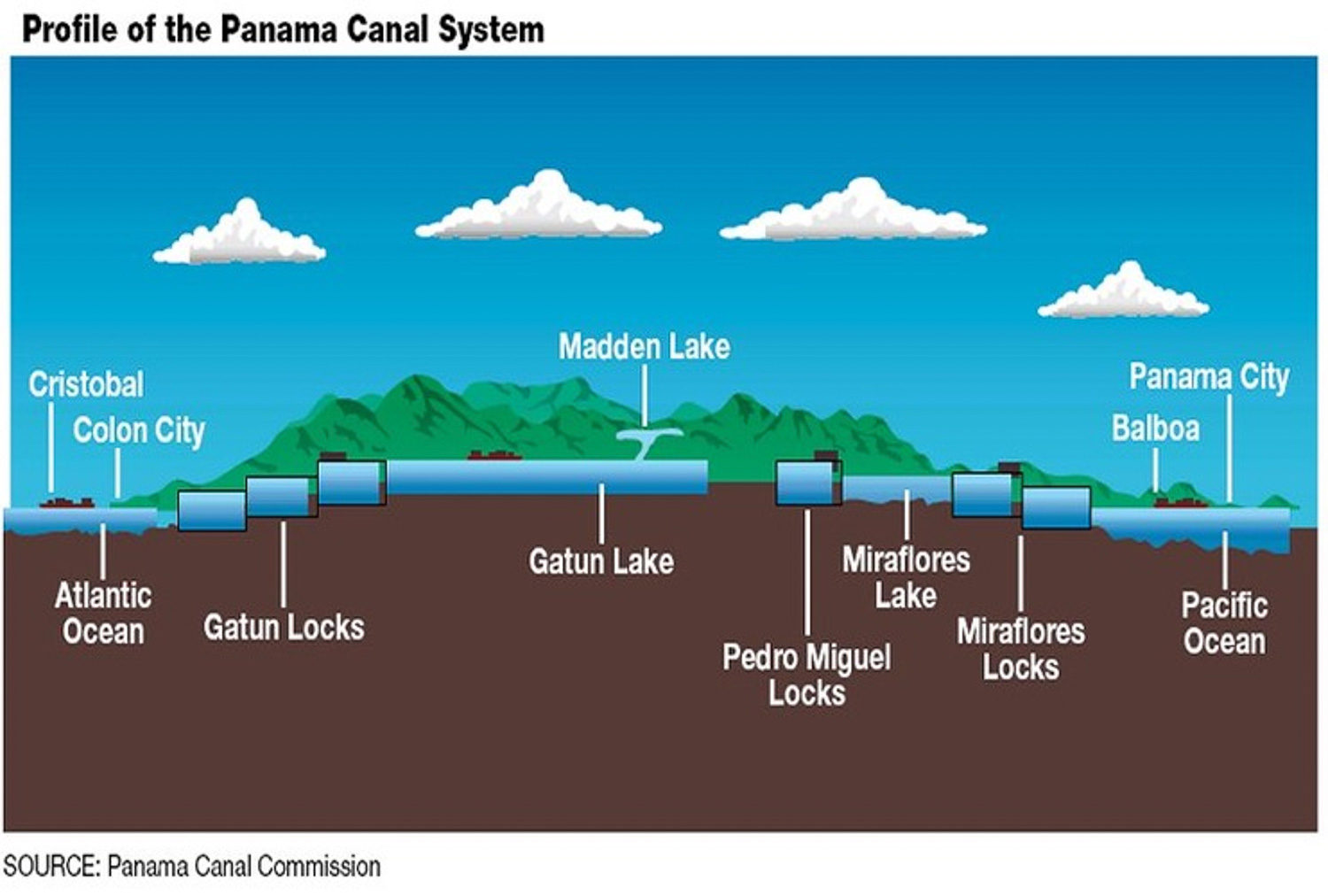
The illustration above shows a cross-section of the canal and the relative location of the locks. A trip through the canal requires ships to go up through three locks to reach Gatun Lake, which sits 85 feet above sea level. At the other end of the canal, of course, ships must go down through three locks to again reach sea level. Our trip started in Panama City on the Pacific and ended in Colon on the Atlantic.
Now, back to your regularly scheduled blog:
* * * * *
We soon passed the Port of Balboa, where tens of thousands of containers were being loaded onto container vessels. Standard containers are either 20 feet or 40 feet long and 8 feet wide. Heights may vary but the standard length and width sizes allow them to be efficiently moved from ships to trains or trucks without having to be unloaded. Container ships can hold up to 20,000 or more twenty-foot-equivalent containers.
As we neared the Miraflores Locks we began to approach the Navig8 Constellation. We would accompany this ship through the locks. Before entering the lock, cables were attached fore and aft to the ship from the “mules” that would keep it centered in the lock during its transit. The ship then slid into the lock. We followed and tied up to a tugboat. Then the gates slowly closed behind us. If you look in the top left corner of the opening photo at the beginning of this post you can see the museum and seats where we had been sitting the previous day (see Part 3).
In case you’re wondering if closing those heavy gates is a tough job, note that they are hollow and buoyant, much like the hull of a ship, so only two 25-hp motors are needed to move each one.
The gates had barely closed when the lock began to fill. It took only about ten minutes to complete that step. My bathtub takes longer to fill than that. The mules continued to center the ship as it moved into the second lock. Since the second lock is higher than the first, the mules must climb a steep incline to maintain the required elevation. There are only about 2 feet of clearance for this size vessel so keeping it centered is critical. We followed and were eventually in the second lock, which also filled quite quickly. When we finally exited the lock the Navig8 Constellation was well ahead making its way to the Pedro Miguel locks.
After exiting the Pedro Miguel Locks we passed under the Centennial Bridge on our way to Gatun Lake. Gatun Lake is huge; 164 square miles. It’s an artificial lake created when the Chagres River was dammed between 1907 and 1913. This is the source of the fresh water that feeds the locks leading to both the Atlantic and the Pacific. The source of the water that feeds Lake Gatun is the rainfall that descends on Panama during its wet season. The mean annual rainfall at Colon, on the Atlantic, is 129.04 inches; at Porto Bello, mid-isthmus, it’s 169.15 inches; and at Balboa, on the Pacific, it’s 91.61 inches. Fortunately, our trip took place during the dry season.
Imagine that you’re on a boat on a beautiful lake. All along the shore you see trees; there are no cities or even vacation cottages. Now add dozens of large ocean-going ships. That’s Gatun Lake. A large part of the trip through the Panama Canal is actually a cruise across this lake. We now had time to have lunch and relax and enjoy the scenery.
About three hours after leaving the Pedro Miguel Locks we were approaching the Gatun Locks, which include the three sets of locks that would take us back down to sea level. We passed the Navig8 Constellation shortly after entering Gatun Lake so we would be sharing this trip through the locks with a different ship, the Strategic Endeavor, a bulk carrier sailing under a Singapore flag. This time we were the first to enter the lock. As we entered, our guides told us to look back at the Strategic Endeavor. As it approached the entrance to the lock, the cables that would connect the ship to the mules were delivered to the ship by two men in a row boat. They had tried to use outboard motors in the past but the motors sometimes fouled the lines. The old “technology” works better for this job. When the gates closed, the water began to drain. We were heading back down to sea level. Our boat was tied up next to one of the lock walls this time. As more of the wall was exposed, many of us touched the wet surface. It was hard to believe that this structure still stood and functioned as it was designed and constructed over a century ago.
After we left the locks we headed under the Atlantic Bridge, which is still under construction. When completed, there will be three bridges across the canal, one near each coast and one mid-isthmus. A boat then raced up alongside a large German-flagged container ship, the Kyoto Express, and the canal pilot climbed out. The same boat then pulled up alongside us and our pilot disembarked.
A large number of ships were visible ahead of us. Some were in pretty bad condition, had no smoke coming from their stacks, and not moving. These appeared to be abandoned in this corner of the lake.
We docked in Colon at about 4:30 PM, approximately 10 hours after leaving Panama City. We were told that we made excellent time. Then we headed off to our Hotel in Colon.
